Gold & Dow Jones Update - Policy Implications
Commodities / Gold & Silver Jul 06, 2007 - 08:40 PM GMTBy: Brian_Bloom
Regular Readers will be aware of the fact that I have recently had the temerity to stick my neck out and call for a strong rise in the Gold price and precious metal related investments.
The two charts below – courtesy Bigcharts.com – are particularly illuminating

The weekly log scale chart of the $XAU (which typically leads the gold price) is reaching for the apex of a triangle. Of course, it could break down from here, but I have formed the view that, given that gold is clearly in a Primary Bull Trend at any level above $585/ounce, any such breakdown is likely to be false and, indeed, the direction of the break is more likely to be “up”.
My view is predicated largely on the conclusion that, in the war between the forces of inflation and deflation, the forces of inflation seem likely to win at this point in time.
The weekly chart below,shows the $XAU relative to the Dow Jones Industrial Index. It can be seen that the $XAU bottomed out in late 2000 (at a point where the distance between the Dow and the $XAU was at its greatest)
In early 2006, the $XAU caught up with the Dow and has since been marking time whilst the Dow has been rising to higher levels.
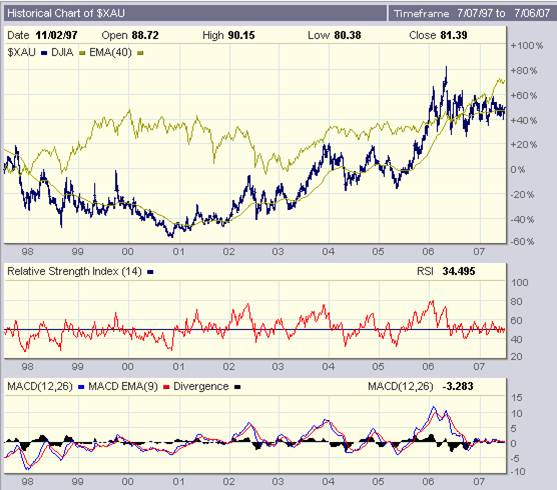
Of course, this begs the question as to ‘Why has the Dow risen to new highs?'
My own view – expressed in previous articles – has been that underlying commercial value has played a lesser role than weight of money. It seems likely that a wave of money has been deliberately thrown at some of the major components of the Dow to cause the Industrial Index to rise. This view has been based on the fact that the broader market as represented by the $SPX has not risen to new highs, and that the industrial equity markets as a whole are extremely vulnerable to severe pullback (if not collapse) as a result of this non confirmation. In short, vested interests are attempting to ‘manage' the markets.
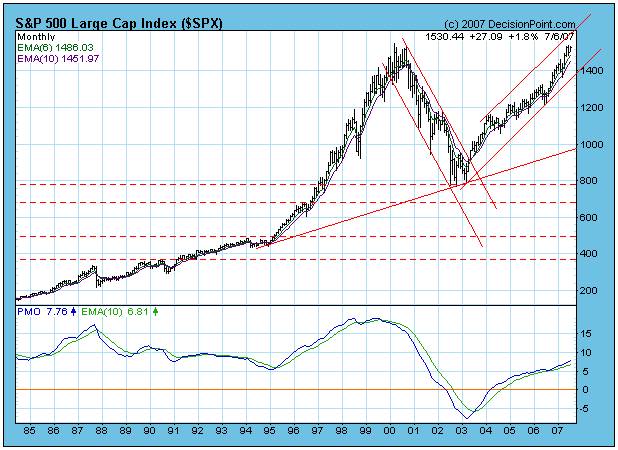
Chart, courtesy Decisionpoint.com
The logic runs something like this: If the Dow Industrials could be “ramped” so as to cause a feeling of euphoria in the markets leading up to the Presidential elections, then it is likely that the $SPX will also rise to new heights (regardless of whether or not this is objectively justifiable by underlying values), and this will cause the $XAU (gold and silver shares) also to rise.
In this event, by reference to the Relative Strength chart above, the $XAU will have some significant catching up to do, and will likely rise at a much faster pace than the Dow.
This expectation is validated by the following (daily) Relative Strength Chart (courtesy stockcharts.com) but caution should be exercised because daily charts are not particularly reliable nowadays.
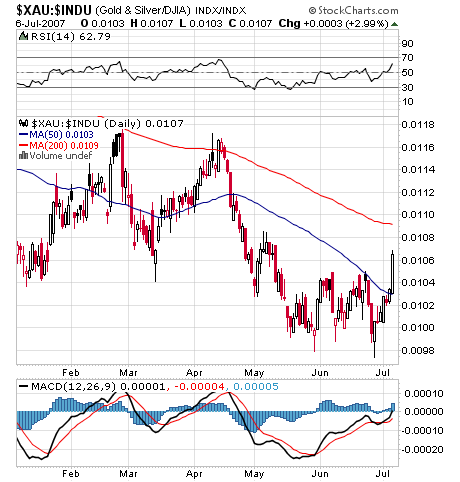
Note the strong non-confirmation of rising bottoms in the MACD and falling bottoms in the price chart; and also the “fact” that the RS chart has penetrated its 200 day MA to the upside.
Arguably, the weekly chart below is even more interesting:

Note the same non confirmation of rising bottoms on the MACD and falling bottoms on the price chart. Note also the uncovered gap at the 50 week MA which occurred in around September 2006. Note also the falling wedge pattern in the RS chart which appears to be reaching its apex. From these various indicators, a ratio of at least .012 may be expected in the medium term. Finally, note that the RSI has some significant upside potential before it reaches overbought territory.
For the sake of completeness and objectivity, the following 3% X 3 box reversal chart of this same relationship is not as clear cut because it is showing the “possibility” of a further fall to a level of 9.23 (0.00923). That this is a possibility as opposed to a probability flows from the fact that at its recently lowest level of 9.8 it had reached its targeted destination based on the horizontal count measuring technique from its previous breakdown from the 11.7 level in 2006. Arguably, having reached the 9.8 level, it may reverse from this point rather than continue down to the 9.23 level.
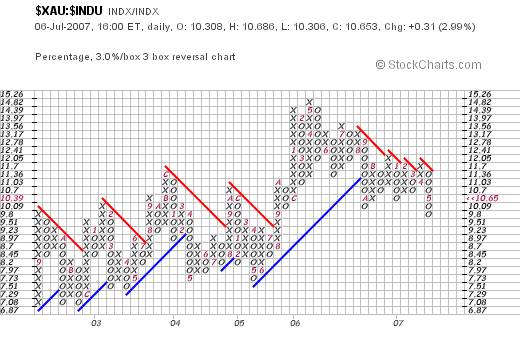
This latter argument is supported by the R/S chart of the Gold Price divided by the Dow below, which shows very limited further downside potential in this particular relationship
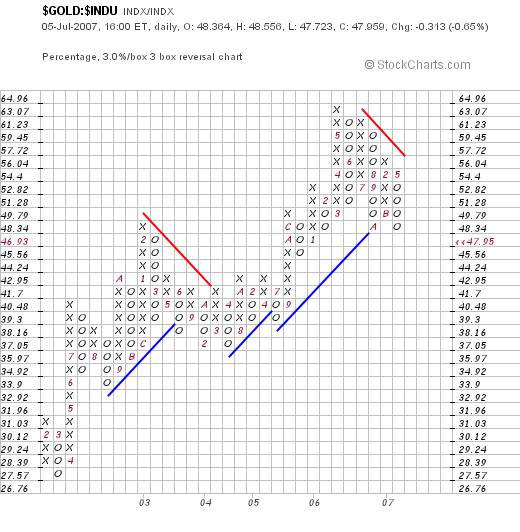
Also of interest is that (in the context of gold being a commodity) the weekly chart of $CRB index below shows:
- Price has broken up out of a falling wedge – implying a minimum upside target of 350
- Price is above both its 17 week and 43 week MA
- The 17 week MA, whilst still below its 43 week MA, is rapidly rising towards it.
- At any price above 322, the $CRB should enter a strongly rising trend as it breaks above the neckline of a reverse Head and Shoulders formation.
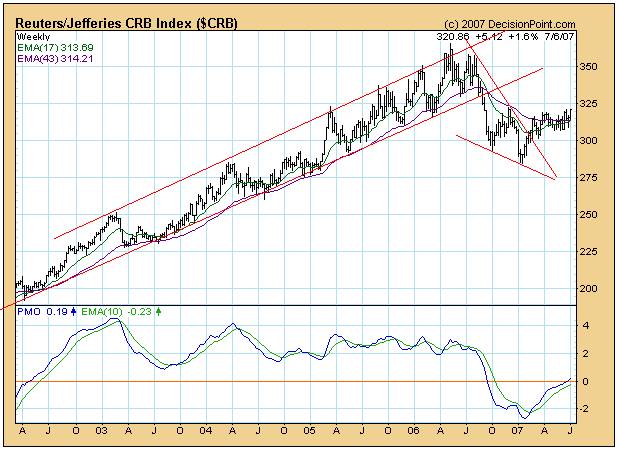
Caution: Except on the daily chart, none of these breakouts has yet occurred. No actual signals have been given. My view that the breakouts will be to the upside flows from subjective interpretation rather than objective interpretation of the charts.
Nevertheless, the primary driver of my logic flows from 25 years of having watched the Central Banks “managing” the markets when the need arose. It all began with a decision by the Reagan administration – facilitated by a structure that was put in place in 1913; and aided and abetted by the players in the Derivatives Industry.
The question has been posed by one reader: “If the Central Banks can ‘manage' the Dow upwards, why can't they manage the gold price downwards at the same time?'
Of course, historically, they have done just this on occasion and the answer is that anything is possible but, in my view, it is not possible to fight a Primary Trend. If the Central Banks move to artificially cause the industrial markets to rise, they cannot have their cake and eat it too. Money will flow into all industrial and commodity markets because of a rising perception of emerging inflationary pressures. The gold market, being a tightly traded market, will become exponentially more difficult to manage if the entire tide is coming in. In the end analysis, the Gold price is the Central Bankers' Achilles Heel. I am currently of the view (which, of course, I reserve the right to change at any time) that the Central Banks have finally painted themselves into a corner from which there is no escape. They are ‘screwed'; and here's why:
If they continue to throw money at the markets, the Dow may enter an exponential blow-off phase which has been building since 1982, as can be seen from the chart below – which dates back to 1920 (courtesy Decisionpoint.com)
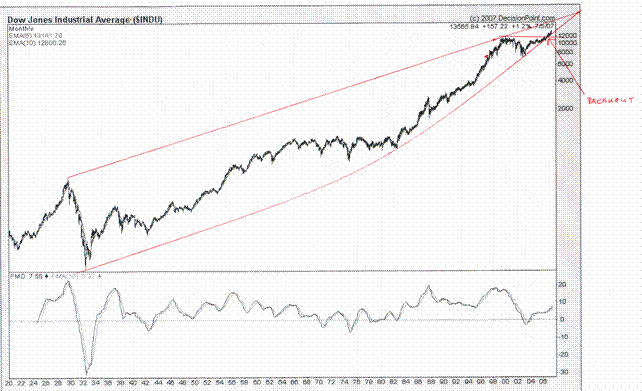
Frankly, it is this analyst's view that the Central Bankers are behaving in a particularly ill-advised manner (if they are indeed actively involving themselves in the markets at this point).
Technically, if the upper trendline is penetrated to the upside then the situation will become unmanageable by any force on Earth. Once the blow-off phase has developed a head of steam there will be no stopping it. Like any other biological phenomenon which reaches such a phase in its evolution, the blow-off will end in catastrophic collapse from which there will be no recovery. The blow-off phase may last anything between 5 to 12 years. (ending at some time between 2012 – 2020)
That this upside penetration seems possible can be observed from the following two charts: (Also courtesy Decisionpoint.com)
Note how the Transport Index is currently bumping its head against the upper trendline, and that the Utilities Index has already broken through !


Is there a way of avoiding a catastrophe?
Yes, I believe there is, but a condition precedent is that Ego needs to make way for humility .
Ultimately, the cause of this emerging blow-off pattern arises from an unwise decision on the part of the Reagan Administration, taken around 1982, to stimulate the world economy by turning the USA into a deficit economy. This was a decision that was inspired by the erroneous Central Bank belief that “money” is what drives the economy. Well intentioned (but ill advised) individuals such as previous Fed Chairman Alan Greenspan believed that money supply can provide a mechanism for controlling the speed of the economy.
Of course, this is true under certain circumstances. However, ultimately, one can only control the speed of any vehicle if that vehicle's engine is in good working order. If you feed increasing amounts of gas to get ever increasing revs per minute from an ageing engine, the consequence is likely to be a cracked cylinder head of a blown gasket or something equally serious. Money supply is the gas that fuels the energy engine of the world economy. i.e. The engine of the world's economy is energy (not money), and that engine is badly in need of overhaul, preferably total replacement.
The way to avoid this looming catastrophe, in this analyst's view, is to throw out the old (Neanderthal) Fossil Fuel driven engine and replace it with a new economic engine based on a suite of New-Paradigm energies. (As an aside, Nuclear Fission is not the way to go).
What we should be actively doing is managing the markets sideways – for upwards of two to three decades – until the Dow Jones once again comes into contact with its lower trendline; from which is can then start rising healthily once again.
The dates all line up. If we fail to implement these new energies, and we fail to manage the markets sideways, the exponential blow-off will explode upwards and peak out between 2012 and 2020. Fascinating to this analyst is that the period between these two dates is in line with when Khabibullo Abdusamatov is arguing our Sun will reach a critical phase of its cooling cycle, and the Earth once again enter a long term Ice Age. (Abdusamatov is high profile opponent of the Greenhouse Gas/Global Warming argument. The term ‘Ice Age' is mine, not his). With this outcome in mind, if we have not put those new energies in place by then, it will be all over bar the shouting.
Are appropriate new energy paradigms available?
Yes, I believe there are three such energy technologies. They are described in some detail in my novel, Beyond Neanderthal.
In conclusion, we need to differentiate between arrogance and intelligence. Whilst (unhappily) society's leaders are primarily motivated by their drive for personal aggrandisement, they are (happily) typically not stupid. The 80 year charts above still show some small room for manoeuvre. The situation is still retrievable even if the markets are ramped up in the lead-up to elections. But our “leaders” are playing an extraordinarily dangerous game. If I had to make any recommendations, it would be this:
Develop a zero tolerance for any misbehaviour on the part of elected officials. Have a read of what Thomas Paine had to say about how elected officials should be behaving – by reference to http://www.ushistory.org/PAINE/commonsense/index.htm . In my view, the time for game playing has passed. Waffle and bullshit are no longer acceptable. It's time to bring to heel those who should be representing the public. Regardless of your political leanings, it's time to hold the politicians accountable for their actions. This may be our last opportunity. Let's not blow it!
By Brian Bloom
www.beyondneanderthal.com
Since 1987, when Brian Bloom became involved in the Venture Capital Industry, he has been constantly on the lookout for alternative energy technologies to replace fossil fuels. He has recently completed the manuscript of a novel entitled Beyond Neanderthal which he is targeting to publish within six to nine months.
The novel has been drafted on three levels: As a vehicle for communication it tells the light hearted, romantic story of four heroes in search of alternative energy technologies which can fully replace Neanderthal Fire. On that level, its storyline and language have been crafted to be understood and enjoyed by everyone with a high school education. The second level of the novel explores the intricacies of the processes involved and stimulates thinking about their development. None of the three new energy technologies which it introduces is yet on commercial radar. Gold, the element , (Au) will power one of them. On the third level, it examines why these technologies have not yet been commercialised. The answer: We've got our priorities wrong.
Beyond Neanderthal also provides a roughly quantified strategic plan to commercialise at least two of these technologies within a decade – across the planet. In context of our incorrect priorities, this cannot be achieved by Private Enterprise. Tragically, Governments will not act unless there is pressure from voters. It is therefore necessary to generate a juggernaut tidal wave of that pressure. The cost will be ‘peppercorn' relative to what is being currently considered by some Governments. Together, these three technologies have the power to lift humanity to a new level of evolution. Within a decade, Carbon emissions will plummet but, as you will discover, they are an irrelevancy. Please register your interest to acquire a copy of this novel at www.beyondneanderthal.com . Please also inform all your friends and associates. The more people who read the novel, the greater will be the pressure for Governments to act.
Brian Bloom Archive |
© 2005-2022 http://www.MarketOracle.co.uk - The Market Oracle is a FREE Daily Financial Markets Analysis & Forecasting online publication.



